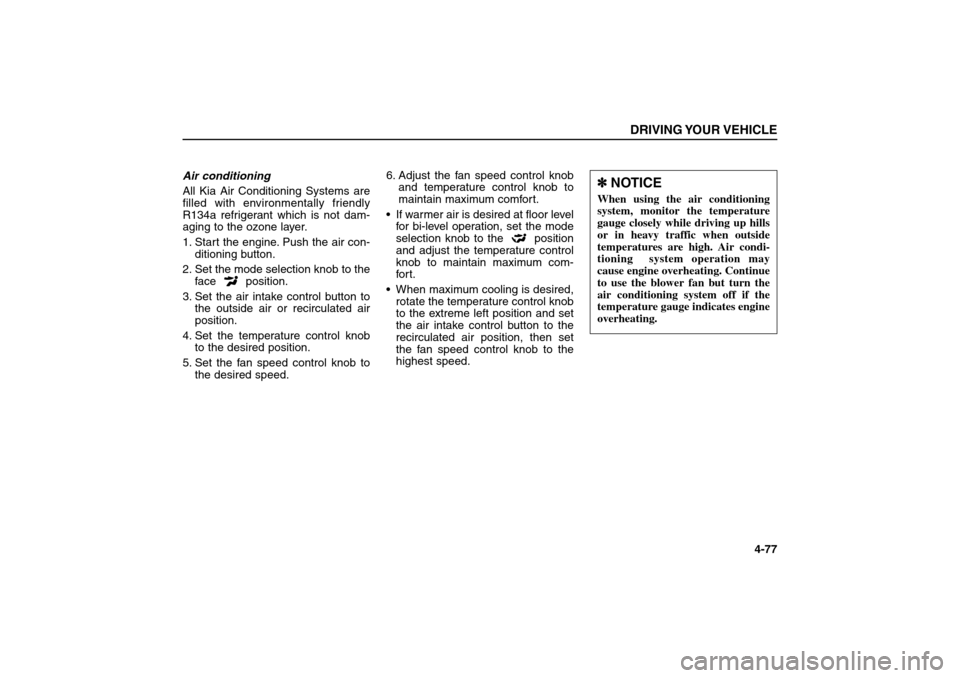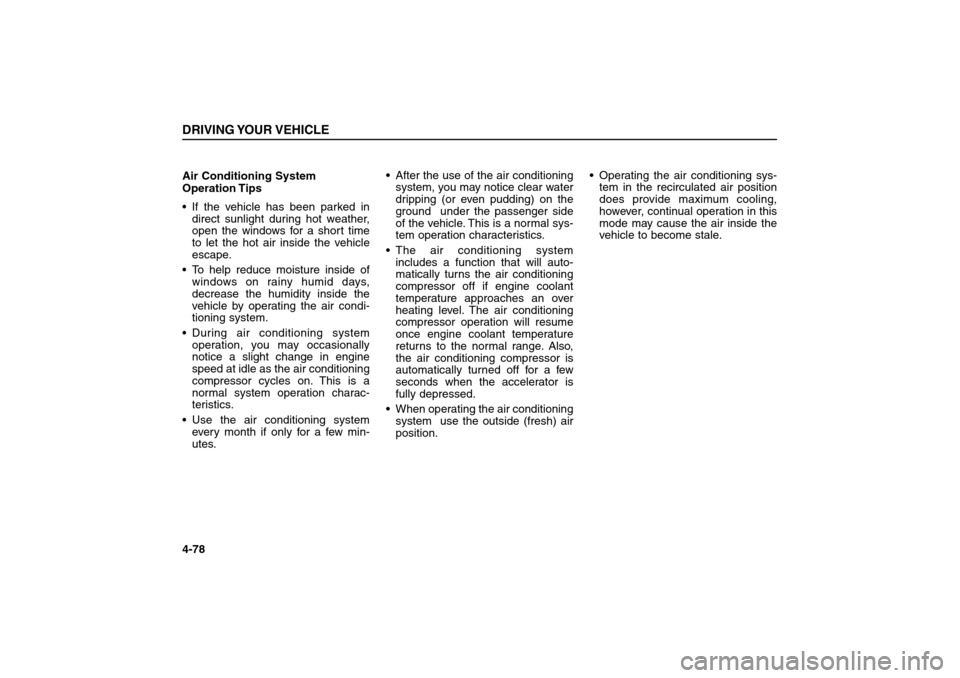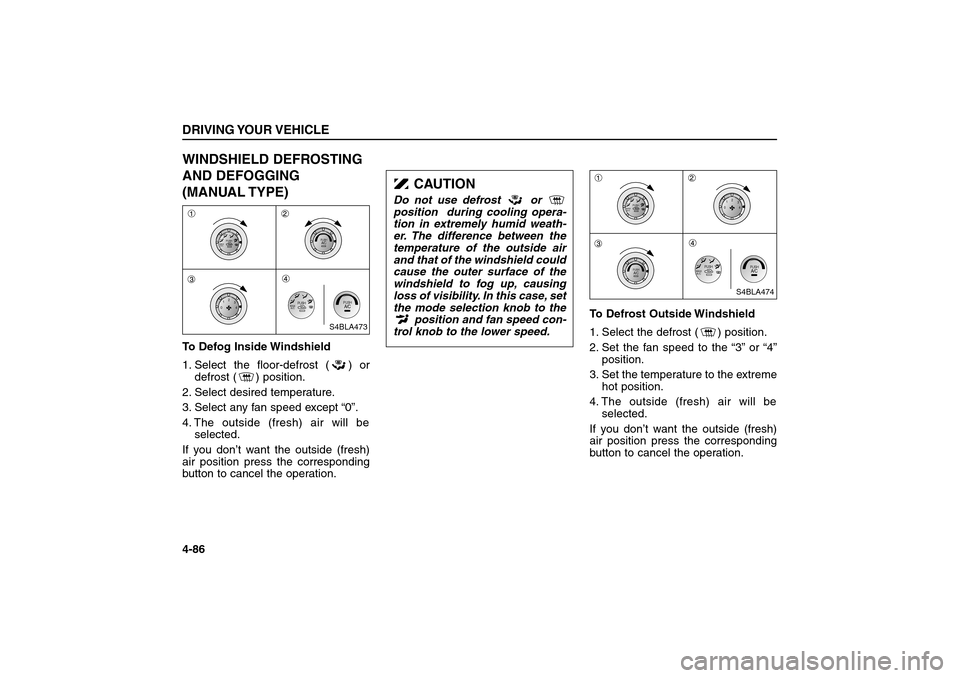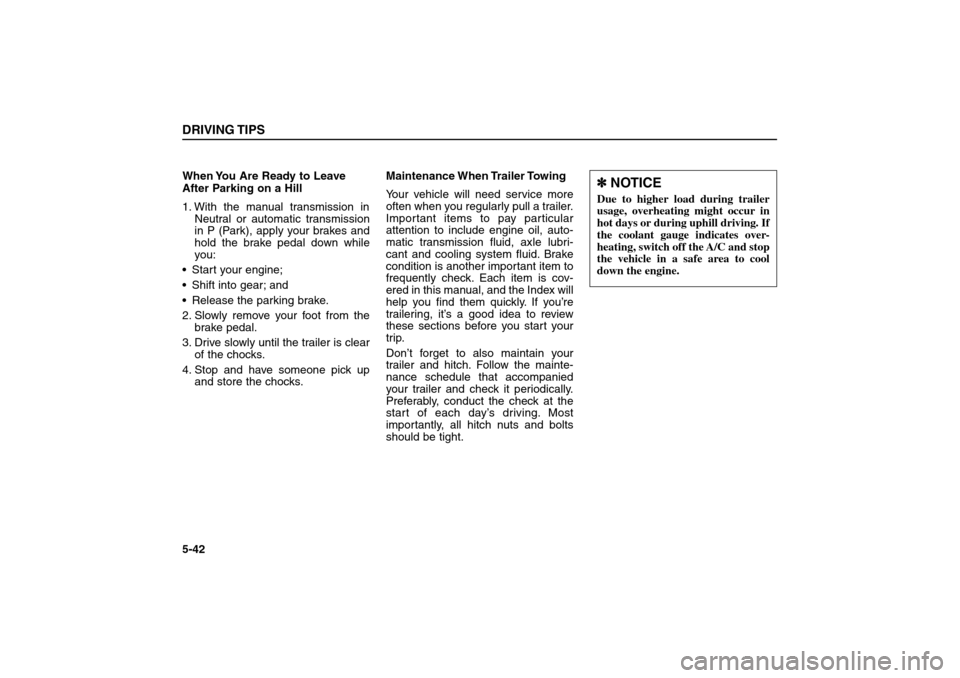cooling KIA Sorento 2006 1.G Owner's Manual
[x] Cancel search | Manufacturer: KIA, Model Year: 2006, Model line: Sorento, Model: KIA Sorento 2006 1.GPages: 312, PDF Size: 5.21 MB
Page 173 of 312

Recirculated air position
If you press the air intake
control button once (recir-
culate), almost all outside
air flow into the vehicle is
shut off, and air within the
vehicle will be recirculated.
This position can be used
temporarily for maximum
heating or cooling (if
equipped with an air condi-
tioning) and to help pre-
vent undesirable outside
air flow into the vehicle.Outside (fresh) air position
If you press the air intake
control button again, the
air position will be changed
to outside (fresh) air and
air will enter the ventilation
system from outside the
vehicle. Use this position
for normal ventilation and
heating.
To reduce the probability of fogging
up the inside of the windshield, the air
intake control is set to the outside
(fresh) air position automatically if
any of following occur.
The mode is selected to the,
or while the system is activated.
The ignition switch is turned off.
The fan is off.
Press the air intake control button to
select the recirculated air position
while the ignition switch is on.
DRIVING YOUR VEHICLE
4-75
CAUTION
Continued climate control sys-
tem operation in the recirculat-
ed air position may allow
humidity to increase inside the
vehicle which may fog the glass
and obscure visibility.
WARNING
Don’t sleep in a vehicle with air
conditioning system or heating
system on. It may cause serious
harm or death to passengers
due to a drop in the oxygen
level and/or body temperature.
BL-ENG (CAN)-4.qxd 7/28/05 5:55 PM Page 75
Page 175 of 312

Air conditioning
All Kia Air Conditioning Systems are
filled with environmentally friendly
R134a refrigerant which is not dam-
aging to the ozone layer.
1. Start the engine. Push the air con-
ditioning button.
2. Set the mode selection knob to the
face position.
3. Set the air intake control button to
the outside air or recirculated air
position.
4. Set the temperature control knob
to the desired position.
5. Set the fan speed control knob to
the desired speed.6. Adjust the fan speed control knob
and temperature control knob to
maintain maximum comfort.
If warmer air is desired at floor level
for bi-level operation, set the mode
selection knob to the position
and adjust the temperature control
knob to maintain maximum com-
for t.
When maximum cooling is desired,
rotate the temperature control knob
to the extreme left position and set
the air intake control button to the
recirculated air position, then set
the fan speed control knob to the
highest speed.
DRIVING YOUR VEHICLE
4-77
✽ ✽
NOTICEWhen using the air conditioning
system, monitor the temperature
gauge closely while driving up hills
or in heavy traffic when outside
temperatures are high. Air condi-
tioning system operation may
cause engine overheating. Continue
to use the blower fan but turn the
air conditioning system off if the
temperature gauge indicates engine
overheating.
BL-ENG (CAN)-4.qxd 7/28/05 5:55 PM Page 77
Page 176 of 312

Air Conditioning System
Operation Tips
If the vehicle has been parked in
direct sunlight during hot weather,
open the windows for a short time
to let the hot air inside the vehicle
escape.
To help reduce moisture inside of
windows on rainy humid days,
decrease the humidity inside the
vehicle by operating the air condi-
tioning system.
During air conditioning system
operation, you may occasionally
notice a slight change in engine
speed at idle as the air conditioning
compressor cycles on. This is a
normal system operation charac-
teristics.
Use the air conditioning system
every month if only for a few min-
utes.After the use of the air conditioning
system, you may notice clear water
dripping (or even pudding) on the
ground under the passenger side
of the vehicle. This is a normal sys-
tem operation characteristics.
The air conditioning system
includes a function that will auto-
matically turns the air conditioning
compressor off if engine coolant
temperature approaches an over
heating level. The air conditioning
compressor operation will resume
once engine coolant temperature
returns to the normal range. Also,
the air conditioning compressor is
automatically turned off for a few
seconds when the accelerator is
fully depressed.
When operating the air conditioning
system use the outside (fresh) air
position.Operating the air conditioning sys-
tem in the recirculated air position
does provide maximum cooling,
however, continual operation in this
mode may cause the air inside the
vehicle to become stale.DRIVING YOUR VEHICLE4-78
BL-ENG (CAN)-4.qxd 7/28/05 5:55 PM Page 78
Page 178 of 312

Automatic Operation
The Full Automatic Temperature
Control (FATC) system automatically
controls the heating and cooling sys-
tem as follows;
1. Push the AUTO button. The indica-
tor light will come on and the
modes, fan speeds, air intake and
air-conditioning will be controlled
automatically by temperature set-
ting.
2. Push the TEMP button to set the
desired temperature.
If the temperature setting is
LO (17°C/62°F), the air condition-
ing system will operate continu-
ously.3. To turn the automatic operation off,
press any button except tempera-
ture control button and AMB but-
ton. If you press the mode selec-
tion button, air-conditioning button,
defrost button, air intake control
button, fan speed button, the
selected function will be controlled
manually while other functions
operate automatically.DRIVING YOUR VEHICLE4-80
AUTO
✽ ✽
NOTICENever place anything over the sen-
sor located on the instrument panel
to ensure better control of the heat-
ing and cooling system.
✽ ✽
NOTICEIf the battery has been discharged
or disconnected, the temperature
mode will reset as Centigrade
degree.
This is normal condition and you
can adjust the temperature mode
from Centigrade to Fahrenheit as
follows;
Press the temperature down button
3 seconds or more with the AMB
button held down. The display
shows that the unit of temperature
is adjusted to Centigrade or
Fahrenheit.
BL-ENG (CAN)-4.qxd 7/28/05 5:55 PM Page 80
Page 179 of 312

Manual Operation
The heating and cooling system can
be controlled manually as well by
pushing buttons other than the AUTO
button. In this case, the system
sequentially works according the
order of buttons selected.
The functions of the buttons which
are not selected will be controlled
automatically.
Press the AUTO button in order to
convert to automatic control of the
system.Temperature Control
Button
The temperature will increase to the
maximum HI (32°C/90°F) by pushing
the up button. Each push of the but-
ton will cause the temperature to
increase by 0.5 °C (1°F).
The temperature will decrease to the
minimum LO (17°C/62°F) by pushing
the down button. Each push of the
button will cause the temperature to
decrease by 0.5°C (1°F).Ambient Button
The ambient temperature will be dis-
played for 5 seconds. before return-
ing to the previous indication.
If you press AMB button again, the
previous indication will be displayed.
DRIVING YOUR VEHICLE
4-81
TEMP
AMB
BL-ENG (CAN)-4.qxd 7/28/05 5:55 PM Page 81
Page 184 of 312

WINDSHIELD DEFROSTING
AND DEFOGGING
(MANUAL TYPE)To Defog Inside Windshield
1. Select the floor-defrost ( ) or
defrost ( ) position.
2. Select desired temperature.
3. Select any fan speed except “0”.
4. The outside (fresh) air will be
selected.
If you don’t want the outside (fresh)
air position press the corresponding
button to cancel the operation.To Defrost Outside Windshield
1. Select the defrost ( ) position.
2. Set the fan speed to the “3”or “4”
position.
3. Set the temperature to the extreme
hot position.
4. The outside (fresh) air will be
selected.
If you don’t want the outside (fresh)
air position press the corresponding
button to cancel the operation.DRIVING YOUR VEHICLE4-86
012
3
4PUSH
PUSH
PUSHA/C
PUSHA/C
MAX
A/C
MAX
A/C
S4BLA473
PUSHA/C
PUSHA/C
012
3
4
PUSHMAX
A/C
PUSHMAX
A/C
S4BLA474
CAUTION
Do not use defrost or
position during cooling opera-
tion in extremely humid weath-
er. The difference between the
temperature of the outside air
and that of the windshield could
cause the outer surface of the
windshield to fog up, causing
loss of visibility. In this case, set
the mode selection knob to the
position and fan speed con-
trol knob to the lower speed.
BL-ENG (CAN)-4.qxd 7/28/05 5:56 PM Page 86
Page 186 of 312

WINDSHIELD DEFROSTING
AND DEFOGGING
(AUTOMATIC TYPE)To Defog Inside Windshield
1. Press the defrost button ( ).
2. Select desired temperature.
3. Select any fan speed except OFF
( ) position.
4. The air-conditioning will be turned
on according to the detected ambi-
ent temperature and outside
(fresh) air position will be selected.
If you don’t want the air-conditioning
or outside (fresh) air position press
the corresponding button to cancel
the operation.To Defrost Outside Windshield
1. Press the defrost button ( ).
2. Set the fan speed to the or
position.
3. Set temperature to the extreme hot
(25°C~32°C) position.
4. The air-conditioning will be turned
on according to the detected ambi-
ent temperature and outside
(fresh) air position will be selected.
If you don’t want the air-conditioning
or outside (fresh) air position press
the corresponding button to cancel
the operation.DRIVING YOUR VEHICLE4-88
S2BLA476
S2BLA477
CAUTION
Do not use defrost position
during cooling operation in
extremely humid weather. The
difference between the temper-
ature of the outside air and that
of the windshield could cause
the outer surface of the wind-
shield to fog up, causing loss of
visibility. In this case, set the
mode selection knob to the
position and fan speed control
knob to the lower speed.
BL-ENG (CAN)-4.qxd 7/28/05 5:56 PM Page 88
Page 190 of 312

EMISSION CONTROL
SYSTEMThe emissions control system of your
vehicle is covered by a written limited
warranty. Please see the warranty
information contained in the Warranty
and Consumer Information Manual in
your vehicle.
Vehicle Modifications
This vehicle should not be modified.
Modification of your Kia could affect
its performance, safety or durability
and may even violate governmental
safety and emissions regulations.
In addition, damage or performance
problems resulting from any modifi-
cation may not be covered under
warranty.Engine Exhaust Gas Precautions
(Carbon Monoxide)
Carbon monoxide can be present
with other exhaust fumes.
Therefore, if you smell exhaust
fumes of any kind inside your vehi-
cle, have it inspected and repaired
immediately by an authorized Kia
dealer. If you ever suspect exhaust
fumes are coming into your vehicle,
drive it only with all the windows
fully open. Have your vehicle
checked and repaired immediately. Do not operate the engine in con-
fined or closed areas (such as
garages) any more than what is
necessary to move the vehicle in or
out of the area.
When the vehicle is stopped in an
open area for more than a short
time with the engine running, adjust
the heating or cooling system (as
needed) to draw outside air into the
vehicle.
Never sit in a parked or stopped
vehicle for any extended time with
the engine running.
When the engine stalls or fails to
start, excessive attempts to re-start
the engine may cause damage to
the emission control system.
DRIVING TIPS
5-3
WARNING
Engine exhaust gases contain
carbon monoxide (CO). Though
colorless and odorless, it is dan-
gerous and could be lethal if
inhaled. Follow the instructions
following to avoid CO poisoning.
BL-ENG (CAN)-5.qxd 7/28/05 5:56 PM Page 3
Page 217 of 312

Driving in Water
Light rain causes no special off-road
driving problems. However, heavy
rain can cause flash flooding, and
flood waters demand extreme cau-
tion.
Find out how deep the water is before
you drive through it. If it’s deep
enough to cover your wheel bearing
hubs, axles, or exhaust pipe, don’t try
it. You probably won’t get through.
Also, water that deep can damage
your axle and other vehicle parts.If the water isn’t too deep, then drive
through slowly. At fast speeds, water
can splash on your ignition system
and your vehicle can stall. Stalling
can also occur if your tailpipe goes
underwater. As long as your tailpipe
is underwater, you will not be able to
start your engine. When you go
through water, remember that it may
take you longer to stop when your
brakes are wet.
If you have driven through water that
was deep enough to cover your
wheel bearing hubs, it may be a good
idea to have an authorized Kia dealer
repack your front wheel bearings and
examine your rear-end fluid for evi-
dence of water.After Off-Road Driving
Remove any brush or debris that has
collected on the underbody, chassis
or under the hood. These accumula-
tions can be a fire hazard.
After driving in mud or sand, clean
and check the brake linings.
Accumulation of mud or sand can
cause glazing and uneven braking.
Check the body structure, steering,
suspension, wheels, tires, and
exhaust system for damage. Also,
check the fuel lines and cooling sys-
tem for any leakage. Your vehicle will
also require more frequent service
due to off-road use.DRIVING TIPS5-30
BL-ENG (CAN)-5.qxd 7/28/05 5:56 PM Page 30
Page 229 of 312

When You Are Ready to Leave
After Parking on a Hill
1. With the manual transmission in
Neutral or automatic transmission
in P (Park), apply your brakes and
hold the brake pedal down while
you:
Start your engine;
Shift into gear; and
Release the parking brake.
2. Slowly remove your foot from the
brake pedal.
3. Drive slowly until the trailer is clear
of the chocks.
4. Stop and have someone pick up
and store the chocks.Maintenance When Trailer Towing
Your vehicle will need service more
often when you regularly pull a trailer.
Important items to pay particular
attention to include engine oil, auto-
matic transmission fluid, axle lubri-
cant and cooling system fluid. Brake
condition is another important item to
frequently check. Each item is cov-
ered in this manual, and the Index will
help you find them quickly. If you’re
trailering, it’s a good idea to review
these sections before you start your
trip.
Don’t forget to also maintain your
trailer and hitch. Follow the mainte-
nance schedule that accompanied
your trailer and check it periodically.
Preferably, conduct the check at the
start of each day’s driving. Most
importantly, all hitch nuts and bolts
should be tight.DRIVING TIPS5-42
✽ ✽
NOTICEDue to higher load during trailer
usage, overheating might occur in
hot days or during uphill driving. If
the coolant gauge indicates over-
heating, switch off the A/C and stop
the vehicle in a safe area to cool
down the engine.
BL-ENG (CAN)-5.qxd 7/28/05 5:56 PM Page 42